No products in the cart.
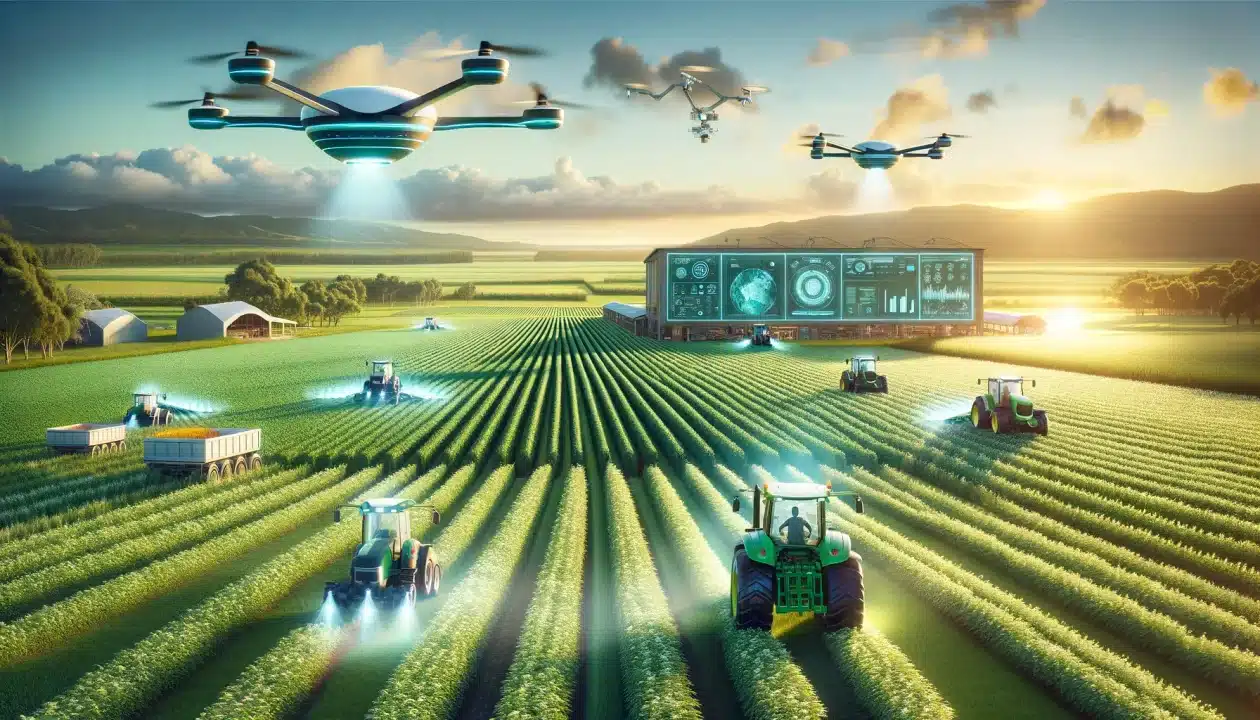
1. Introduction:
Across the United States, farmers are battling a silent crisis that directly threatens food security: water scarcity and declining crop yields. From California’s parched fields to the unpredictable weather in the Midwest, agricultural productivity is at risk. Over 80% of freshwater in the U.S. is consumed by agriculture, yet inefficient irrigation and climate volatility are causing water waste and yield uncertainty on a massive scale.
Adding to the challenge, changing rainfall patterns and increasing heatwaves make traditional farming techniques unreliable. With shrinking water tables and rising input costs, many U.S. farmers are being pushed to the edge.
Enter AI Solving Water and Yield Issues, a powerful tool that’s not only predicting problems before they happen but actively reshaping how farms operate. From optimizing irrigation schedules to predicting yield outcomes, AI-powered smart farming tools are solving two of the industry’s most pressing issues: water efficiency and productivity.
This transformation isn’t happening in the distant future, it’s unfolding now across thousands of American farms implementing AI Solving Water and Yield Issues. And the results? Higher crop outputs, lower water usage, and more sustainable operations.
In this article, we’ll uncover how AI technologies are being deployed to tackle these dual threats. Through a practical, real-world lens, we’ll examine the specific problems farmers face, the AI-driven solutions addressing them, and the case studies proving their impact.
Let’s explore how data, sensors, and machine learning are giving U.S. farms a fighting chance at resilience.
2. Problem #1 – Water Waste and Inefficiency
Water is the backbone of American agriculture, yet it’s being used inefficiently at alarming rates. Traditional irrigation methods, like flood and spray systems, often lead to excessive runoff and evaporation, wasting thousands of gallons per acre. According to the USDA, up to 50% of water used in farming never reaches plant roots, especially in arid regions like California and Arizona.
AI Solving Water and Yield Issues presents a viable solution to this growing problem by bringing precision to water management. Climate change is intensifying droughts, shrinking aquifers, and putting even more pressure on water supplies. As rainfall becomes less predictable, farmers find it harder to plan irrigation schedules or know when and how much to water. These outdated practices don’t just cost money, they directly reduce crop yields and soil quality.
Adding to the problem is the lack of real-time data. Without precise insights into soil moisture levels, weather conditions, and crop water needs, most farmers are left guessing. This guesswork leads to overwatering some fields and underwatering others, both of which negatively affect plant growth and long-term sustainability.
The cost implications are steep, water bills are rising, and yield losses from drought mismanagement continue to climb. And with U.S. agriculture consuming the majority of freshwater resources, there’s growing pressure from environmental groups and policymakers to adopt smarter solutions.
The good news? Emerging technologies are offering a path forward. In the next section, we’ll explore how AI-enabled irrigation systems are helping farmers overcome these inefficiencies, preserving water while enhancing productivity.

3. Solution – Smart Irrigation & AI Monitoring Tools
To combat widespread water inefficiency in farming, U.S. farms are rapidly turning to AI-powered irrigation systems. These systems combine real-time data from soil moisture sensors, weather forecasts, and crop needs to precisely determine when, where, and how much to water.
Unlike traditional irrigation, which treats every field the same, smart irrigation systems use machine learning to adapt watering strategies to specific zones and crops. If one area is retaining more moisture due to recent rainfall or soil composition, the system adjusts automatically, conserving water while ensuring plants receive exactly what they need.
Some farms now use drone-based imaging and satellite data to monitor evapotranspiration and water stress, feeding that data into AI platforms that optimize irrigation in real time. This not only eliminates guesswork but significantly cuts down on water waste and utility costs.
Companies like CropX, Arable, and Farmonaut are leading the way by offering platforms that deliver actionable insights through mobile apps. Farmers get instant updates and alerts on their smartphones, making remote farm management easier and more efficient.
Most importantly, results speak volumes: farms using AI-based irrigation report up to 30% reductions in water usage and 10–20% yield increases. In drought-prone areas, this tech is proving to be a lifeline.
The most effective applications of AI Solving Water and Yield Issues come in the form of smart irrigation systems. These technologies are helping farmers overcome inefficiencies, with some operations reporting 30% water reductions while increasing yields by 10-20%.
4. Problem #2 – Yield Loss Due to Unpredictable Conditions
Unpredictable weather is becoming the new normal for U.S. farmers, and it’s wreaking havoc on crop yields. Late frosts, extended droughts, flash floods, and erratic heatwaves can all devastate a season’s worth of effort within days. The result? Billions in crop losses every year and increased instability across the agricultural supply chain.
Traditionally, farmers have relied on historical data and personal experience to make yield projections. But with climate variability increasing, those methods are no longer reliable. Delays in planting, improper harvest timing, and missed fertilization windows all stem from misjudged seasonal conditions, contributing to shrinking outputs and financial losses.
On top of that, pest and disease outbreaks, which often correlate with shifting weather patterns, are harder to anticipate without advanced analytics. As a result, farmers end up applying fertilizers and pesticides either too late or too often, which leads to wasted resources, lower yields, and environmental strain.
With climate variability increasing, traditional farming methods are failing. This is where AI Solving Water and Yield Issues makes its second major impact, providing tools to anticipate and adapt to changing conditions.
This is where AI enters the picture with transformative capabilities. In the next section, we’ll explore how AI-powered crop monitoring and predictive analytics are not just minimizing loss, but helping farms thrive, even in the face of environmental uncertainty.

5. Solution – AI-Powered Crop Monitoring and Predictive Analytics
To tackle the yield crisis, more U.S. farmers are turning to AI-powered crop monitoring and predictive analytics. These tools go far beyond simple observation, they collect and interpret massive volumes of data in real time to deliver accurate, farm-specific insights on crop health, growth stages, and potential threats.
Using remote sensing technologies, such as drones and satellites, AI platforms scan fields for changes in plant color, canopy density, and soil conditions. Algorithms then detect signs of stress, whether from pests, nutrient deficiencies, or drought, long before the human eye can. This early warning system enables farmers to act quickly and precisely, often preventing major crop loss.
Predictive analytics models further enhance decision-making by forecasting yields based on weather data, historical patterns, and current field inputs. These models help determine the optimal times for planting, watering, and harvesting, reducing guesswork and maximizing productivity. Some tools even simulate “what-if” scenarios, allowing farmers to understand how changes in fertilizer application or irrigation might affect outcomes.
AI farming platforms like Prospera, Granular, and Climate FieldView are now widely used across the U.S., helping thousands of farmers optimize operations from their smartphones or tablets. These systems reduce dependency on chemical inputs, increase operational efficiency, and ultimately result in higher yields with fewer resources.
Platforms implementing AI Solving Water and Yield Issues are now widely used across the U.S., helping farmers optimize operations from their smartphones. These systems exemplify how AI Solving Water and Yield Issues is transforming reactive farming into proactive management.
6. Case Study – Smart Farms in Action
One of the most compelling ways to understand the power of AI in agriculture is by seeing it in action. Across the United States, several farms have become early adopters of AI-driven farming tools, demonstrating significant gains in both water conservation and crop yields.
Take, for example, a corn farm in Iowa that implemented AI-based irrigation systems and crop health monitoring. By using real-time data from drone imagery and soil sensors, the farm optimized its watering schedule, cutting water usage by 35% while increasing corn yields by 20%. These results were achieved not by working harder, but by working smarter, with AI guiding every decision.
Another case in West Lafayette, Indiana, saw smallholder farmers using AI-powered platforms like Farmonaut to detect crop diseases early and receive precise treatment suggestions. This not only reduced pesticide use but also boosted overall field productivity. Data visualization tools on mobile apps made the technology user-friendly and accessible even to those new to digital tools.
Meanwhile, in California’s Central Valley, AI-driven platforms helped farmers track evapotranspiration levels and adjust irrigation in real time, reducing both water waste and energy costs. Farmers reported more sustainable outputs and improved soil health over consecutive growing seasons.
These case studies prove that AI isn’t just theory, it’s delivering measurable results. Farms of all sizes are benefiting, and with the increasing affordability of smart tools, the tech is more accessible than ever.
Real-world examples demonstrate the power of AI Solving Water and Yield Issues:
- An Iowa corn farm using this technology cut water usage by 35% while increasing yields by 20%
- Indiana farmers applied AI Solving Water and Yield Issues to detect diseases early, reducing pesticide use
These cases prove AI Solving Water and Yield Issues delivers measurable results across farm sizes and regions.
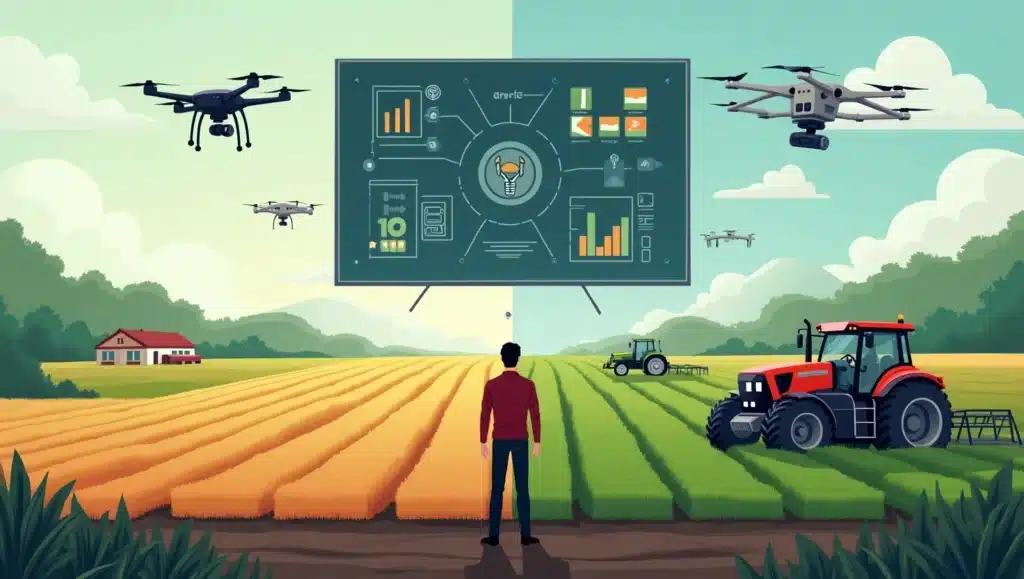
7. Conclusion – The Future of AI in American Farming
The future of U.S. agriculture is being shaped by AI technology, and the impact is already profound. AI in farming isn’t just a passing trend; it’s a fundamental shift that is transforming the industry’s ability to manage water usage, increase yields, and fight climate change. As AI tools become more accessible and affordable, even small farms can implement these smart farming solutions, making the technology a viable option across diverse agricultural landscapes.
AI Solving Water and Yield Issues represents more than temporary fixes – it’s laying the groundwork for a sustainable agricultural future. As these tools become more accessible, their role in Solving Water and Yield Issues will only grow more significant. The time for farmers to embrace this technology is now, with benefits that will extend for generations to come.
Moreover, as sustainability becomes a higher priority, AI will play a pivotal role in making U.S. farms more environmentally responsible. Precision irrigation, crop monitoring, and predictive analytics are just the beginning. Future innovations promise even more sophisticated, resource-efficient practices that will help farmers adapt to ever-changing environmental conditions while protecting the planet’s resources.
In conclusion, AI is a game-changer for U.S. agriculture, it’s not just solving today’s challenges, it’s laying the groundwork for a more resilient, sustainable future. The time for farmers to embrace this technology is now, and the results will be far-reaching for generations to come.
FAQs:
Q1. How does AI help with water management in agriculture?
AI helps optimize irrigation systems by using real-time data to determine precise watering schedules, reducing water waste and improving efficiency. Sensors and AI algorithms ensure that crops receive the right amount of water, preventing over- or under-watering.
Q2. Can AI improve crop yields in the face of climate change?
Yes, AI-powered crop monitoring and predictive analytics can help farmers anticipate weather changes, manage resources better, and adjust farming practices, resulting in higher and more consistent crop yields.
Q3. What are the main AI tools used on U.S. farms?
Common AI tools include smart irrigation systems, crop monitoring sensors, machine learning models for yield prediction, and drones for real-time field imaging and analysis, all designed to increase efficiency and sustainability.
Q4. Are AI technologies accessible to small-scale farmers?
Yes, AI technologies are becoming more affordable and user-friendly, allowing even small farmers to integrate them into their operations. Tools like mobile apps and cloud-based platforms are making smart farming accessible across various farm sizes.
Q5. What are the long-term benefits of using AI in farming?
Long-term benefits include improved sustainability, reduced resource waste (such as water and chemicals), increased productivity, and better resilience to climate change, ensuring long-term viability for farms across the U.S.
Related Articles
Soil & Water Management
How AI Can Help Young Farmers Succeed in U.S. Agriculture
1. Introduction: Farming in the United States is at a crossroads. With...
Soil & Water Management
AI and Sustainable Farming: Can Technology Save the Planet?
1. Introduction: Can the very industry that feeds the world also be...
Soil & Water Management
AI for Seed Selection: Choosing the Right Crops for Maximum Yield
1. Introduction: Every successful harvest begins with one critical decision, choosing the...
Soil & Water Management
AI in Soil Health: How Smart Tech is Improving Crop Productivity
1. Introduction: Healthy soil is the foundation of a productive farm, but...

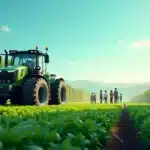





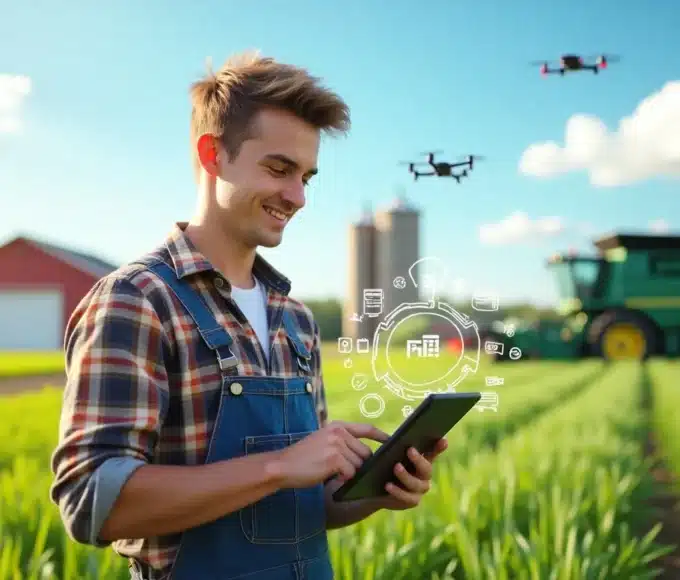
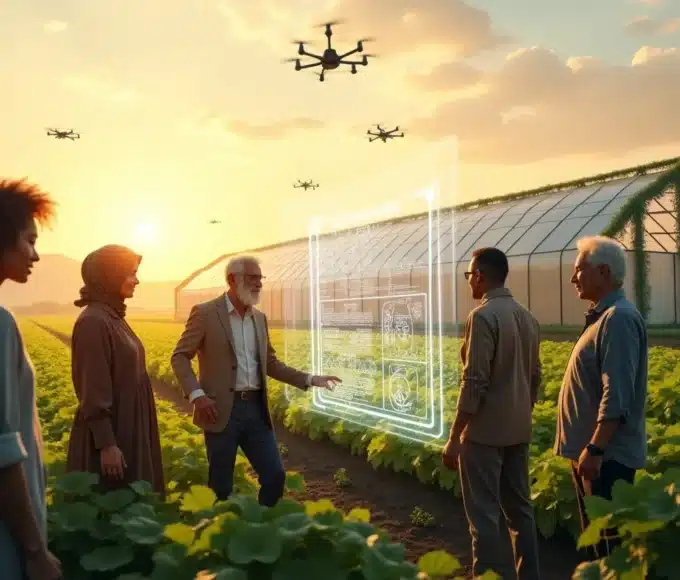
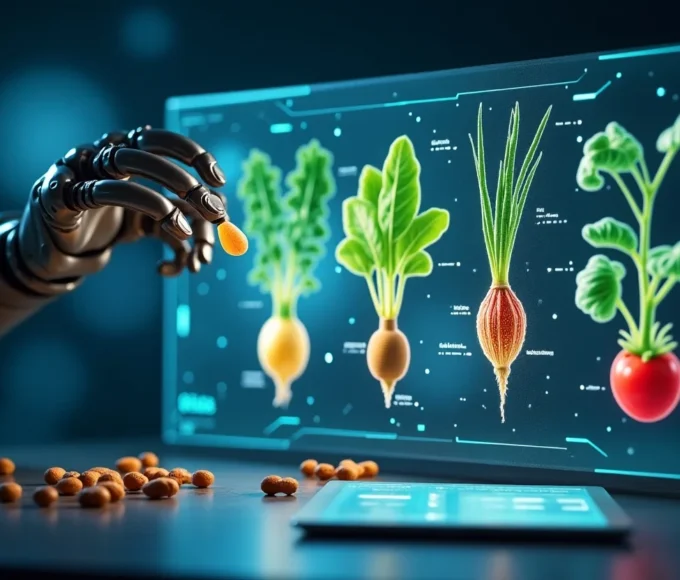
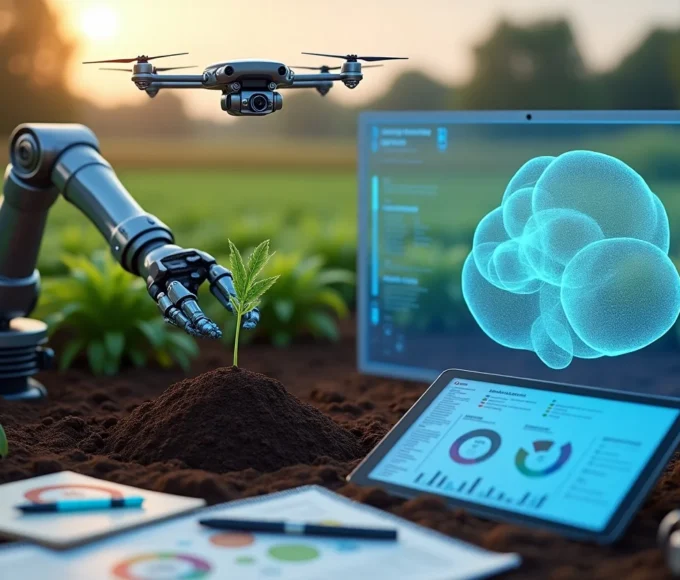
Leave a comment